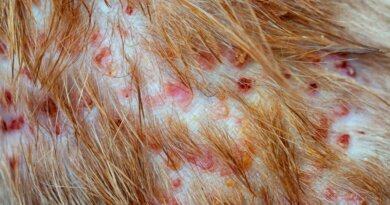Purebred or Hybrid, Which is Best?
Pros and Cons of Crossbred Dogs by Deinah Storm | Last Updated 04-13-2021
Consider the Crossbred Dogs, also known as Hybrids, Mixed Breeds, and Designer Dogs, are they superior to purebred dogs? There is considerable controversy about these types of dogs. So what’s the problem?
With the rising demand for exotic pets in the market, there has been an increasing practice for dog breeders to crossbreed two distinctively different dog breed.
 Chihuahua and Jack Russell Terrier (Pros and Cons of Crossbred Dogs)
Chihuahua and Jack Russell Terrier (Pros and Cons of Crossbred Dogs)Crossbreeding does happen, but a lot of people stimulate crossbreeding for the pure purpose of producing genetically superior, physically exotic and characteristically efficient dogs.
Purebred dogs are a breed of dogs that come from the ancestors of the same race and breeding standards whereas crossbreeds are those dogs that have a separate kind of parents and ancestors, all bred in different conditions.
You can make a differentiation between the breeds through a simple process called DNA Dog Testing. There are several kits available in the market that you can purchase.
All you have to do is take a cotton swab of the dog’s mouth and provide a hair sample. The samples are sent to a laboratory to determine the genes of the dog and give information on the crossbreeds’ family tree.
While many people advocate cross breeding of dogs, there are others who are against it. To understand the mixed opinions about cross-breeding let us examine the pros and cons of crossbreed dogs.
Pros and Cons of Crossbred Dogs
Pros and Cons of Crossbred Dogs:The Pros
 Morkie: A Maltese and Yorkshire Terrier Crossbred dog (in Pros and Cons of Crossbred Dogs)
Morkie: A Maltese and Yorkshire Terrier Crossbred dog (in Pros and Cons of Crossbred Dogs)Health
Since
purebred dogs are the product of inbreeding within the same genetic breed of
dogs over a long course of time, you can predict the accurate size and physical
appearance and behavior of the dog. They are however more prone to genetic
defects and inherited diseases.
Crossbreeds,
on the other hand, are a mixture of the different breed of dogs with no genetic
relations. The genetic diversity of the dog makes them healthier.
A Note About Genetic Diversity
All purebred dogs living today are the result of a small group of individuals often called foundation stock.
These first individuals are the grandparents of all living members of the breed. At some point in history, the breed is set, and the “studbooks” are closed so to speak.
All this means is that if you want to register a purebred dog, both parents must also be part of that same breed. With some breeds, only a handful of individuals provide the genes for the entire breed.
With so much inbreeding, healthy genetic diversity cannot occur and therefore, the breed is subjected to health problems as a result.
Scientists refer to the general health and hardiness of an animal that comes from a larger gene pool as hybrid vigour.
It is, however, important to pay attention to the parents of the hybrid breed to guarantee better health.
If both parents have the same genetic health issues, it is most likely that the product will inherit it too, and are often more severe than the parents’ weaknesses.
When this happens, the positive health benefits of the hybrid mix no longer applies.
Extended Lifespan
Most crossbreeds develop a more resilient immune system as compared to purebreds.
They have lower risks of heart disease, cancer and neurological problems which make them live longer than purebreds due to the hybrid vigor of the descendants whereas purebred dogs often show symptoms of deteriorating health especially if two purebred dogs that are closely related are used for mating purposes.
Potentially Superior Characteristics
 Maltese and Poodle Mix (Maltipoo) Pros and Cons of Crossbred Dogs
Maltese and Poodle Mix (Maltipoo) Pros and Cons of Crossbred DogsIn crossbreeding, you are also able to modify the physical appearance and combine different qualities to a certain extent to make the puppies stronger, efficient and better looking.
Overtime, many of today’s purebred dogs, have lost their original appearance and as a result, have acquired devastating health problems.
Consider the English Bulldog. Here is an example of how humans have changed the look and consequently the health of one breed due to inbreeding. The English bulldogs of today look nothing like those from even 100 years ago.
Crossbred dogs show better temperament than purebred dogs as their genetic memory becomes diluted through the process of cross-breeding.
For example, if you place a purebred hunting dog at home, it would still show instinctive behavior to hunt which can be troublesome for the owners. Crossbred dogs, on the other hand, would lose this mechanical behavior and would be more adaptable to other pets and surroundings and thus make better pets.
In an ideal situation, you can produce puppies that have the desirable characteristics of both parents.
For example, many breeders will use poodles (toys, miniatures, or standard size dogs) to mate with another breed to help reduce shedding or make the puppies more hypoallergenic.
Goldendoodles and Labradoodles are are a result of such a plan. This was a deliberate attempt to create a working dog/service dog that would be suitable for people who had allergies.
Combination of the Best
 Bichon Frise and Shih Tzu mix “Shichon” (Pros and Cons of Crossbred Dogs)
Bichon Frise and Shih Tzu mix “Shichon” (Pros and Cons of Crossbred Dogs)If you like the look of a Cocker Spaniel but prefer the friendly character of a Labrador, you can cross breed the two, and if you are lucky enough, you can get the better of the two traits.
Combining two qualities, however, is not possible with pure breeds as they all usually have the same characteristics and physical features, so there is not much to choose.
Economical
Most purebreds cost thousands of dollars because it is difficult to maintain their purity, the breeding process and they are usually rare to find.
Crossbreeds, on the other hand, are low maintenance. They are sold at a reasonable price and are readily available at animal shelters. Since crossbreeds are healthier and more resilient, medical support expenses are much lesser too.
Foundations of a Brand-new Breed
 Beagle and Pug Mixed Breed or “Puggle” (Pros and Cons of Cross Bred Dogs
Beagle and Pug Mixed Breed or “Puggle” (Pros and Cons of Cross Bred DogsThere are almost 400 distinct dog breeds world-wide, some much older than others. What they all have in common except some primitive breeds is the the fact that each had a human’s hand in its creation.
Early breeders would start with two or more breeds and combine them in a way to create just the perfect breed for their needs. Perhaps the breeder was a hunter who needed a dog with better eyesight or one that could run faster or farther.
They would pick and choose from available breed, adding genes here and there until a new breed emerged.
This is happening today as breeders are experimenting and combining purebred dogs to create still another dog breed with superior qualities.
Pros and Cons of Crossbred Dogs: The Cons
Haphazard Size, Appearance, and Temperament
Since it is difficult to determine how many sets of genes the resulting puppy gets from both parents when they are crossbred, it is difficult to predict what the puppies will inherit.
If two small breed dogs are mated, the size of the offspring is likely to be small. However, it is difficult to predict what will happen if you mate a larger dog with a smaller dog. Puppies might be big, or small, or somewhere in between.
Temperament is another factor that has a strong genetic component. There again, there is no guarantee which temperamental traits might be passed on to the litter.
You might get “lucky” and have a puppy with the most desirable traits of both parents, or you might end up with puppies that fall short in many different ways.
Since crossbreeding has become very fashionable, it is often easy to predict the appearance of the puppies, but that is not a hard and fast rule.
Even when two purebred dogs are mated together, you can end up with puppies whose appearance does not resemble either parent.
Different dog breeds have different longevity. Calculating a purebred dog’s age in human years is complicated enough but mixing two kinds makes it even harder to figure the final years.
So you are left with having to guess how how long the puppy will live which is disheartening for many dog owners.
Random Characteristics
 Poodle – Chihuahua Mixed Breed “Chipoo” Pros and Cons of Crossbred Dogs
Poodle – Chihuahua Mixed Breed “Chipoo” Pros and Cons of Crossbred DogsPurebreds have a history of breed development. Each dog breed was originally developed to do a certain job, even if the only job was to be a companion.
Over many years and many generations of breeding, these traits are well defined. A dog bred solely to be a companion is not likely to flush out foxes, or hunt vermin.
When you mix a great ratter with a pure companion dog, you won’t know which traits are passed onto the offspring. This makes it more difficult to train. It is hard to determine how it will react to certain situations. Management and training may be more challenging
Difficult Whelping
Defects of the puppies and injuries of the bitch may happen when you don’t match the sizes of the parent correctly.
A big male is most likely to result in bigger puppies, but if the female is small, it could be a threat to the safety of the mother and the pups while giving birth.
Large puppies make the probability of a Caesarean Section much more likely. Without emergency medical attention, the pups might survive but not the mother.
For this reason, some people believe that it is unethical to crossbreed dogs with noticeable differences.
Genetics Doesn’t Come with a Guarantee
Many crossbred puppies are very healthy, live long lives and bring great joy to their human companions. Some end up being cuter that the parents and possess traits such as a more hypoallergenic coat or a more intelligent disposition.
There are no guarantees, however, for these favourable results to occur. Most breeds that we have today were developed throughout many many years by devoted breeders with the patience to persist until their chosen dog bred true to form.
High Price Tag
 Husky and Pomeranian Mix or Pomsky (Pros and Cons of Mixed Breed Dogs)
Husky and Pomeranian Mix or Pomsky (Pros and Cons of Mixed Breed Dogs)While you would expect to pay less for a crossbred dog, the reality is sometimes the opposite. Many breeders will charge more, a lot more, for these hybrids. They slap on the name designer dogs and paint a picture of them being somehow superior to purebreds and thus able to command a larger price.
This is not a new phenomenon, and many people interested in making a quick buck will borrow their neighbor’s dog to mate with their own and then charge high fees for the offspring. When this happens, all of the positive characters and fear of crossbreed dogs disappear. Unfortunately, many of crossbred dogs we see today come from huge commercial kennels and puppy mills.
So, no matter which dogs you prefer, consider taking a DNA Dog test to determine the best type of dog that would suit your lifestyle because dogs treated unethically is one of the most disheartening things that concerns every pet owner.
The Pros and Cons of Crossbred Dogs by Deinah Storm

Author’s Bio: Deinah Storm is a pet lover from the US who has had cats and dogs all her life.
When she’s not walking her dogs with her family, she spends time writing informational and interesting blogs about pets to share with pet lover communities.
If you found Pros and Cons of Crossbred Dogs Helpful, May we suggest
Does This Article Deserve Your Thumbs Up?
We always appreciate your support and encouragement. Your thumbs up means so much to us. Please like this article.
If you find this page or any page on Small Dog Place Helpful, or Useful in anyway, I’d love it if you would click the small heart found on the bottom right of each page.
You can also share or bookmark this page — just click on the:

Free Monthly Newsletter
Sign Up for Our Free Newsletter and get our Free Gift to You.
my E-book, The Top 10 Mistakes People Make When Choosing a Dog (and how to avoid them)
If you enjoyed this page, I’d love it if you’d let me know. Just click the button below. Thank you.
Sharing is Caring





Read information now. All trends of medicament.
https://edonlinefast.com
Best and news about drug. Read information now.